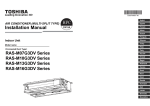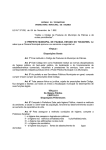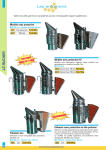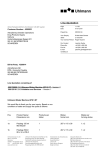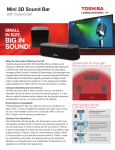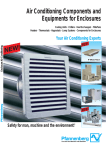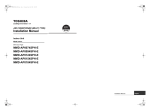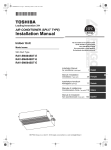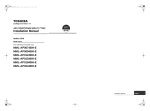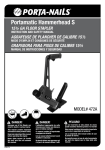Download Installation Manual
Transcript
EG55760001-00 English AIR CONDITIONER (MULTI-SPLIT TYPE) Installation Manual Español Français Italiano Deutsch Português Indoor Unit Model name: <Concealed Duct Type> RAS-M07G3DV Series RAS-M10G3DV Series RAS-M13G3DV Series RAS-M16G3DV Series Ελληνικα Türkçe Polski Česky Русский Hrvatski Magyar Nederlands Svenska Suomi Norsk Dansk Română Български Eesti Latviski Slovenčina Slovenščina –1– Contents 1 2 3 4 6 7 8 9 Precautions for safety . . . . . . . . . . . . . . . . . . . . . . . . . . . . . . . . . . . . . . . 1 Accessory parts . . . . . . . . . . . . . . . . . . . . . . . . . . . . . . . . . . . . . . . . . . . . 5 Selection of installation place . . . . . . . . . . . . . . . . . . . . . . . . . . . . . . . . 5 Installation . . . . . . . . . . . . . . . . . . . . . . . . . . . . . . . . . . . . . . . . . . . . . . . . 7 Duct design . . . . . . . . . . . . . . . . . . . . . . . . . . . . . . . . . . . . . . . . . . . . . . 12 Refrigerant piping . . . . . . . . . . . . . . . . . . . . . . . . . . . . . . . . . . . . . . . . . 14 Electrical connection. . . . . . . . . . . . . . . . . . . . . . . . . . . . . . . . . . . . . . . 15 Others . . . . . . . . . . . . . . . . . . . . . . . . . . . . . . . . . . . . . . . . . . . . . . . . . . . 16 Installation Manual 1 Precautions for safety The manufacturer shall not assume any liability for the damage caused by not observing the description of this manual. Be sure to read this installation manual carefully before installing. It is recommended that maintenance be performed by a specialist when the unit has been operated for a long time. Be sure to follow the precautions provided here to avoid safety risks. The symbols and their meanings are shown below. DANGER : It indicates that incorrect use of this unit can result in a high possibility of severe injury (*1) or death. WARNING : It indicates that incorrect use of this unit may cause severe injury or death. CAUTION : It indicates that incorrect use of this unit may cause personal injury (*2), or property damage (*3). *1 : A severe injury refers to blindness, injury, burns (hot or cold), electrical shock, bone fracture, or poisoning that leaves aftereffects and requires hospitalization or extended out-patient treatment. *2 : Personal injury means a slight accident, burn, or electrical shock which does not require admission or repeated hospital treatment. *3 : Property damage means greater damage which affects assets or resources. Power supply cord of parts of appliance for outdoor use shall be at least polychloroprene sheathed flexible cord (design H07RN-F) or cord designation60245 IEC66 (1.5 mm2 or more). (Shall be installed in accordance with national wiring regulations.) CAUTION New refrigerant air conditioner installation EN-1 EN-2 THIS INSTRUCTION CAN RESULT IN FIRE OR EXPLOSION. • TO PREVENT OVERHEATING THE INDOOR UNIT AND CAUSING A FIRE HAZARD, PLACE THE UNIT WELL AWAY (MORE THAN 2 M) FROM HEAT SOURCES SUCH AS RADIATORS, HEATERS, FURNACE, STOVES, ETC. • WHEN MOVING THE AIR CONDITIONER FOR INSTALLING IT IN ANOTHER PLACE AGAIN, BE VERY CAREFUL NOT TO GET THE SPECIFIED REFRIGERANT (R410A) WITH ANY OTHER GASEOUS BODY INTO THE REFRIGERATION CYCLE. IF AIR OR ANY OTHER GAS IS MIXED IN THE REFRIGERANT, THE GAS PRESSURE IN THE REFRIGERATION CYCLE BECOMES ABNORMALLY HIGH AND IT RESULTINGLY CAUSES BURST OF THE PIPE AND INJURIES ON PERSONS. • IN THE EVENT THAT THE REFRIGERANT GAS LEAKS OUT OF THE PIPE DURING THE INSTALLATION WORK, IMMEDIATELY LET FRESH AIR INTO THE ROOM. IF THE REFRIGERANT GAS IS HEATED BY FIRE OR SOMETHING ELSE, IT CAUSES GENERATION OF POISONOUS GAS. • WHEN INSTALLING OR RE-INSTALLING THE AIR CONDITIONER, DO NOT INJECT AIR OR OTHER SUBSTANCES BESIDES THE DESIGNATED REFRIGERANT “R410A” INTO THE REFRIGERATING CYCLE. IF AIR OR OTHER SUBSTANCES ARE MIXED, AN ABNORMAL PRESSURE CAN OCCUR IN THE REFRIGERATING CYCLE, AND THIS CAN CAUSE AN INJURY DUE TO A PIPE RUPTURE. • THIS AIR CONDITIONER USES THE NEW HFC REFRIGERANT (R410A), WHICH DOES NOT DESTROY THE OZONE LAYER. R410A refrigerant is apt to be affected by impurities such as water, oxidizing membranes, and oils because the pressure of R410A refrigerant is approx. 1.6 times of refrigerant R22. As well as the adoption of this new refrigerant, refrigerating machine oil has also been changed. Therefore, during installation work, be sure that water, dust, former refrigerant, or refrigerating machine oil does not enter the refrigeration cycle of a new-refrigerant air conditioner. To avoid mixing refrigerant and refrigerating machine oil, the sizes of charging port connecting sections on the main unit are different from those for the conventional refrigerant, and different size tools are also required. For connecting pipes, use new and clean piping materials with high pressure withstand capabilities, designed for R410A only, and ensure that water or dust does not enter. Moreover, do not use any existing piping as its pressure withstand may be insufficient and may contain impurities. DANGER • FOR INSTALLATION BY QUALIFIED PERSONS ONLY. • MEANS FOR DISCONNECTION FROM THE SUPPLY HAVING A CONTACT SEPERATION OF AT LEAST 3 mm IN ALL POLES MUST BE INCORPORATED IN THE FIXED WIRING. • TURN OFF MAIN POWER SUPPLY BEFORE ATTEMPTING ANY ELECTRICAL WORK. MAKE SURE ALL POWER SWITCHES ARE OFF. FAILURE TO DO SO MAY CAUSE ELECTRIC SHOCK. • CONNECT THE CONNECTING CABLE CORRECTLY. IF THE CONNECTING CABLE IS CONNECTED WRONGLY, ELECTRIC PARTS MAY BE DAMAGED. • CHECK THE EARTH WIRE THAT IT IS NOT BROKEN OR DISCONNECTED BEFORE INSTALLATION. • DO NOT INSTALL NEAR CONCENTRATIONS OF COMBUSTIBLE GAS OR GAS VAPORS. FAILURE TO FOLLOW EN-3 WARNING • Installation work must be requested from the supplying retail dealership or professional vendors. Self-installation may cause water leakage, electrical shock, or fire as a result of improper installation. • Specified tools and pipe parts for model R410A are required, and installation work must be done in accordance with the manual. HFC type refrigerant R410A has 1.6 times more pressure than that –2– EN-4 EN Installation Manual –3– of conventional refrigerant (R22). Use the specified pipe parts, and ensure correct installation, otherwise damage and/or injury may be caused. At the same time, water leakage, electrical shock, and fire may occur. • Be sure to install the unit in a place which can sufficiently bear its weight. If the load bearing of the unit is not enough, or installation of the unit is improper, the unit may fall and result in injury. • Electrical work must be performed by a qualified electrical engineer in accordance with the code governing such installation work, internal wiring regulations, and the manual. A dedicated circuit and the rated voltage must be used. Insufficient power supply or improper installation may cause electrical shock or fire. • Use a cabtyre cable to connect wires in the indoor/outdoor units. Midway connection, stranded wire, and single-wire connections are not allowed. Improper connection or fixing may cause a fire. • Wiring between the indoor unit and outdoor units must be well shaped so that the cover can be firmly placed. Improper cover installation may cause increased heat, fire, or electrical shock at the terminal area. • Be sure to use only approved accessories or the specified parts. Failure to do so may cause the unit to fall, water leakage, fire or electrical shock. • After the installation work, ensure that there is no leakage of refrigerant gas. If the refrigerant gas leaks out of the pipe into the room and is heated by fire or something else from a fan heater, stove or gas range, it causes generation of poisonous gas. • Make sure the equipment is properly earthed. Do not connect the earth wire to a gas pipe, water pipe, lightning conductor, or telephone earth wire. Improper earth work may be the cause of electrical shock. • Do not install the unit where flammable gas may leak. If there is any gas leakage or accumulation around the unit, it can cause a fire. EN-5 Installation Manual • Do not select a location for installation where there may be excessive water or humidity, such as a bathroom. Deterioration of insulation may cause electrical shock or fire. • Installation work must be performed following the instructions in this installation manual. Improper installation may cause water leakage, electrical shock or fire. Check the following items before operating the unit. - Be sure that the pipe connection is well placed and there are no leaks. - Check that the service valve is open. If the service valve is closed, it may cause overpressure and result in compressor damage. At the same time, if there is a leak in the connection part, it may cause air suction and overpressure, resulting burst or injury. • In pump down operations, ensure to perform the following procedures. - Do not inject air into the refrigeration cycle. - Be sure to close both service valves and stop the compressor before removing the refrigerant pipe. If removing the refrigerant pipe while the compressor is operating with the service valves opened, it may cause to air absorbed and abnormal high pressure inside the refrigeration cycle and resulting burst or injury. • Do not modify the power cable, connect the cable midway, or use a multiple outlet extension cable. Doing so may cause contact failure, insulation failure, or excess current, resulting in fire or electrical shock. • Do not use any refrigerant different from the one specified for complement or replacement. Otherwise, abnormally high pressure may be generated in the refrigeration cycle, which may result in a failure or explosion of the product or an injury to your body. • Be sure to comply with local regulations/codes when running the wire from the outdoor unit to the indoor unit. (Size of wire and EN-6 • Follow the instructions in this installation manual to arrange the drain pipe for proper drainage from the unit. Ensure that drained water is discharged. Improper drainage can result in water leakage, causing water damage to furniture. • Tighten the flare nut with a torque wrench using the prescribed method. Do not apply excess torque. Otherwise, the nut may crack after a long period of usage and it may cause the leakage of refrigerant. • Wear gloves (heavy gloves such as cotton gloves) for installation work. Failure to do so may cause personal injury when handling parts with sharp edges. • Do not touch the air intake section or the aluminum fins of the outdoor unit. It may cause injury. • Do not install the outdoor unit in a place which can be a nest for small animals. Small animals could enter and contact internal electrical parts, causing a failure or fire. • Request the user to keep the place around the unit tidy and clean. • Make sure to conduct a trial operation after the installation work, and explain how to use the unit to the customer in accordance with the manual. Ask the customer to keep the operation manual along with the installation manual. wiring method etc.) • Places where iron or other metal dust is present. If iron or other metal dust adheres to or collects on the interior of the air conditioner, it may spontaneously combust and start a fire. • If you detect any damage, do not install the unit. Contact your supplying dealer immediately. • Do not install in a place which cannot bear the weight of the unit. Personal injury and property damage can result if the unit falls. • When installing the air conditioner in a small room, provide appropriate measures to ensure that the concentration of refrigerant leakage occur in the room does not exceed the critical level. It is not dangerous refrigerant; it has not toxicity or combustibility. However, a concentration above 0.3 kg/m³ as criterion still causes suffocation. The volume of refrigerant charged to the Multi System air conditioner is more than the volume charged to a conventional individual system. • When wiring, use the specified cables and connect the terminals securely to prevent external forces applied to the cable from affecting the terminals. • Install the access port (ceiling opening) at least 2.5 m above the floor level and attach the grille (locally procured) to the air intake section since otherwise the users may injure themselves or receive electric shocks if they poke their fingers or other objects into the indoor unit while the air conditioner is running. CAUTION • Exposure of unit to water or other moisture before installation could result in electric shock. Do not store it in a wet basement or expose to rain or water. • After unpacking the unit, examine it carefully for possible damage. • Do not install in a place that can increase the vibration of the unit. Do not install in a place that can amplify the noise level of the unit or where noise and discharged air might disturb neighbors. EN-7 –4– EN-8 EN Installation Manual –5– 2 3 Accessory parts Part name Installation Manual Q’ty Shape Usage 1 This manual (Be sure to hand over to customers) M10 × Ø34 For hanging down the unit Insulating pipe 2 Washer 8 Hose band 1 For connecting drain pipe Flexible hose 1 For adjustment of drain pipe centering Heat insulator 1 For insulating drain connecting section Signal receiving unit 1 Mounting bracket 1 Screw 2 Screw 2 Wood Screw 2 Spacer 4 Pattern template 1 Remote controller 1 Battery 2 Remote controller holder 1 Screw 2 Owner's Manual 1 CD-ROM 1 EN-9 Installation Manual For insulating pipe connecting section For signal receiving unit M4 x 25 mm M4 x 40 mm Ø3.8 x 16 mm For signal receiving unit For signal receiving unit For signal receiving unit For signal receiving unit 95 mm x 51 mm For signal receiving unit For remote controller Ø3.1 x 16 mm Selection of installation place Avoid installing in the following places Select a location for the indoor unit where the cool or warm air will circulate evenly. Avoid installation in the following kinds of locations. • Saline area (coastal area) • Locations with acidic or alkaline atmospheres (such as areas with hot springs, factories where chemicals or pharmaceuticals are made and places where the exhaust air from combustion appliances will be sucked into the unit). Doing so may cause the heat exchanger (its aluminum fins and copper pipes) and other parts to become corroded. • Locations with atmospheres with mist of cutting oil or other types of machine oil. Doing so may cause the heat exchanger to become corroded, mists caused by the blockage of the heat exchanger to be generated, the plastic parts to be damaged, the heat insulators to peel off, and other such problems to result. • Locations where vapors from food oils are formed (such as kitchens where food oils are used). Blocked filters may cause the air conditioner’s performance to deteriorate, condensation to form, the plastic parts to be damaged, and other such problems to result. • Places where iron or other metal dust is present. If iron or other metal dust adheres to or collects on the interior of the air conditioner, it may spontaneously combust and start a fire. • Locations near obstructions such as ventilation openings or lighting fixtures where the flow of the blown air will be disrupted (a disruption of the air flow may cause the air conditioner’s performance to deteriorate or the unit to shut down). • Locations where an in-house power generator is used for the power supply. The power line frequency and voltage may fluctuate, and the air conditioner may not work properly as a result. • On truck cranes, ships or other moving conveyances. • The air conditioner must not be used for special applications (such as for storing food, plants, precision instruments or art works). (The quality of the items stored may be degraded.) • Locations where high frequencies are generated (by inverter equipment, in-house power generators, medical equipment or communication equipment). (Malfunctioning or control trouble in the air conditioner or noise may adversely affect the equipment’s operation.) • Locations where there is anything under the unit installed that would be exposed to wet risk. (If the drain has become blocked or when the humidity is over 80 %, condensation from the indoor unit will drip, possibly causing damage to anything underneath.) • In the case of the wireless type of system, rooms with the inverter type of fluorescent lighting or locations exposed to direct sunlight. (The signals from the wireless remote controller may not be sensed.) • Locations where organic solvents are being used. • The air conditioner cannot be used for liquefied carbonic acid cooling or in chemical plants. • Location near doors or windows where the air conditioner may come into contact with high-temperature, highhumidity outdoor air. (Condensation may occur as a result.) • Locations where special sprays are used frequently. For remote controller holder For some models only EN-10 Installation Manual Installation under high-humidity atmosphere <Under air intake> In some cases including the rainy season, especially inside of the ceiling may become high-humidity atmosphere (dew-point temperature: 23 °C or higher). 1. Installation to inside of the ceiling with tiles on the roof 2. Installation to inside of the ceiling with slated roof 3. Installation to a place where inside of the ceiling is used for pathway to intake the fresh air 4. Installation to a kitchen • In the above cases, additionally attach the heat insulator to all positions of the air conditioner, which come to contact with the high-humidity atmosphere. • Apply also a sufficient heat insulation to the duct and connecting part of the duct. [Reference] Condensation test conditions Ceiling Air inlet 50 or more 450 Access port (Ceiling opening) Ceiling 450 Access port (Ceiling opening) Air inlet 24 °C wet bulb temperature Low air volume, operation time 4 hours Ceiling Installation space 450 Access port (Ceiling opening) Drain piping Air outlet Ceiling 450 Model type A M07,10,13G3DV 1,250 M16G3DV 1,450 235 or more 210 5 or more Refrigerant piping A 2500 or more 100 or more EN Air inlet 300 or more 27 °C dry bulb temperature Indoor side: Air volume: 100 <Back air intake> Access port (Ceiling opening) Floor surface Access port A Access port 450 Air outlet EN-11 –6– EN-12 –7– 4 Installation Manual Installation • To move the indoor unit, hold the hooking brackets (4 positions) only. • Do not apply force to the other parts (refrigerant pipe, drain pan, foamed parts, resin parts or other parts). • Hanging bolt pitch of air intake chamber side is different (centre position), make sure not to make mistake to install the setting direction. • Carry the package by two or more persons, and do not bundle it with plastic band at positions other than specified. • To install vibration isolation material to hanging bolts, confirm that it does not increase the unit vibration. CAUTION Strictly comply with the following rules to prevent damage of the indoor units and human injury. • Do not put a heavy article on the indoor unit or let a person get on it. (Even units are packaged) • Carry in the indoor unit as it is packaged if possible. If carrying in the indoor unit unpacked by necessity, use buffering cloth or other material not to damage the unit. External dimensions 25 or less (Only the position of an access cover.) Unit external dimension C (Outside) Hanging bolt 210 Unit external dimension B 125 (Outside) (Unit: mm) Hanging bolt pitch A Access cover 187 Refrigerant pipe connecting port 56 155 22 40 58 (Liquid side) 35 Electrical control box 40 113 80 320 37 100 90 knockout hole (For air taking-in) EN-13 (Gas side) 110 388 Refrigerant pipe connecting port 300 260 Unit external dimension 450 80 Hanging bolt pitch 370 Drain pipe connecting port Wires drawing-out port 173 Model type A B C M07,10,13G3DV 770 700 650 M16G3DV 970 900 850 EN-14 Installation Manual Installation of hanging bolt Installation of indoor unit • Consider the piping / wiring after the unit is hung to determine the location of the indoor unit installation and orientation. • After the location of the indoor unit installation has been determined, install hanging bolts. • For the dimensions of the hanging bolt pitches, refer to the external view. • When a ceiling already exists, lay the drain pipe, refrigerant pipe, control wires, and remote controller wires to their connection locations before hanging the indoor unit. Procure hanging bolts washer and nuts for installing the indoor unit (these are not supplied). Treatment of ceiling Hanging bolt M10 or W3/8 4 pieces Nut M10 or W3/8 12 pieces Washer M10 8 pieces Installation of hanging bolt Use M10 hanging bolts (4 pcs, locally procured). Matching to the existing structure, set pitch according to size in the unit external view as shown below. Side view Incorrect Hanging bolt (W3/8 or M10) Nut (W3/8 or M10) 5 or less EN The ceiling differs according to structure of building. For details, consult your constructor or interior finish contractor. In the process after the ceiling board has been removed, it is important to reinforce ceiling foundation (frame) and to keep horizontal level of installed ceiling correctly in order to prevent vibration of ceiling board. • Attach the nuts and the M10 flat washers to the hanging bolt. • Put washers at up and down of the hanging bracket of the indoor unit to hang down the indoor unit. • Check that four sides are horizontal with a level gauge. (Horizontal degree: Within 5 mm) Set the air intake and air discharge sides are within 5 mm with each other. Changing from under air intake to back air intake M10 flat washer Remove the suction board cover attached to the back, and screw it to the bottom of unit. M10 flat washer Suction board Nut (W3/8 or M10) New concrete slab Install the bolts with insert brackets or anchor bolts. (Blade type bracket) (Slide type bracket) Rubber Anchor bolt (Pipe hanging anchor bolt) Steel frame structure Use existing angles or install new support angles. Hanging bolt REQUIREMENT • Hang the unit in a horizontal position. When unit is hanged to slant, it may cause overflow of drainage. • Install the unit within the dimension according to the figure below. • Use level gauge to confirm whether the unit is hang horizontally. Front view Hanging bolt Support angle Existing concrete slab Incorrect Use a hole-in anchors, hole-in plugs, or a hole-in bolts. 5 or less Drain pump side Drain pump side Remove the top and bottom fan case screws, and fasten the fan case with the suction board. Set the drain pipe connecting port side within 5 mm lower than opposite side. EN-15 –8– EN-16 –9– Installation location of receiving unit The sensor of indoor unit with wireless remote controller can receive a signal by distance within approx. 8 m. Based upon it, determine a place where the remote controller is operated and the installation place. • Operate the remote controller, confirm that the indoor unit receives a signal surely, and then install it. • Keep 1 m or more from the devices such as television, stereo. (Disturbance of image or noise may generate.) • To prevent a malfunction, select a place where is not influenced by a fluorescent light or direct sunlight. Installation Manual 3. Connect the housing of Signal receiving unit with the connector of wires extended from the indoor unit. (Fig. 2) 4. Reattach the upper case. Mounting on the ceiling Wire housing Fig.2 8 m 1. Cut a section out of the ceiling along the provided paper pattern (95 x 51 mm). 2. Pass the wire through the provided mounting bracket and insert the bracket into the installation hole. (Fig. 3) or ss le Fig.3 How to Install the Signal Receiving Unit To prevent electric shocks, embed the wires in the wall and do not expose them. When installing wires on the wall, be sure to cover them with insulating materials. Note: • To avoid malfunction of the remote controller, do not assemble or run remote control wiring together with the power cables, and do not enclose them in the same metal conduit. • When the power unit induces electrical noise, it is recommended that a noise filter or the like be installed. Installing into the switch box Switch box (Locally procured) 1. Insert a flathead screwdriver or similar tool into the groove, Signal receiving and remove the lower case. (Fig. 1) Spacer unit 2. Fix the lower case with M4 x 25 mm screws provided. Do not overly tighten, and use the provided spacers. If the Signal receiving unit does not fit in the wall, cut spacers to adjust the clearance. Part (A) Part (B) Fig.4 Signal receiving unit Lower case Screw M4 x 25 mm Fig.1 3. Use bracket parts (A) and (B) to securely grip the ceiling material. (Fig. 4) 4. Connect the housing of Signal receiving unit with the connector of wires extended from the indoor unit. 5. Insert a slotted screwdriver into the opening at the bottom of the remote controller. Remove the lower case from the signal receiving unit. 6. Adjust the provided spacers so that they are several millimeters larger than the thickness of the ceiling material. Pass the 2 supplied screws (M4 x 40 mm) through the spacers and tighten them enough to hold the Signal receiving unit in place. 7. Return parts (A) and (B) through the gap between the ceiling and Signal receiving unit so that they are contained in the openings. Then tighten the screws. Do not tighten the screws excessively. This may result in damage or deformation of the case. Tighten to the point where the Signal receiving unit can be moved slightly by hand. (Fig. 5) 8. Firmly attach the signal receiving unit to the lower case. Fig.5 EN-17 EN-18 Installation Manual Drain piping Pipe material, size and insulator The following materials for piping work and insulating process are procured locally. CAUTION Following the Installation Manual, perform the drain piping work so that water is properly drained. Apply a heat insulation so as not to cause a dew condensation. Inappropriate piping work may result in water leakage in the room and wet furniture. 1.5 m to 2 m (Collective piping) Downward slope 1/100 or more REQUIREMENT • Connect hard vinyl chloride pipes securely using an adhesive for vinyl chloride to avoid water leakage. • It takes some time until the adhesive is dried and hardened (refer to the manual of the adhesive). Do not apply stress to the joint with the drain pipe during this time period. Insert the flexible drain hose into the upper drain pipe and fix it with the hose band. Hose band Flexible drain hose As long as possible (Approx. 10 cm) Incorrect 15 mm or less* Drain pipe connecting port (Transparent) Socket for VP25 (Locally procured) Hard socket Adhesive inhibited : Use the attached flexible hose and hose band for connecting the drain hose to the clear drain socket. If applying the adhesive, socket will be damaged and cause water leakage. 10 mm Heat insulator Remove the drain pump connector CN504. * For gravitational drainage, remove the white connector (CN504) on the P.C. board in the electrical control box. CN504 White 10 to 12 mm Hose band tightening margin Indoor unit Indoor unit Trap VP30 Upper pipe Gravitational drainage Gravitational drainage can be changed to natural water draining for models with a drain pump by following the steps below. 1 Downward slope 1/100 or more VP25 vinyl chloride pipe Drain pipe Attached hose band (Locally procured) connecting port Attached flexible hose (Hard socket) Soft socket Foamed polyethylene foam, thickness: 10 mm or more • Connect a hard socket (locally procured) to the hard socket of the attached supplied flexible hose. • Connect a drain pipe (locally procured) to the connected hard socket. Arched shape Heat insulator Hard vinyl chloride pipe VP25 (Nominal outer diameter Ø32 mm) Insulator Connection of drain hose • Provide the indoor drain piping with proper heat insulation. • Provide the area where the pipe connects to the indoor unit with proper heat insulation. Improper heat insulation will cause condensation to form. • The drain pipe must be sloping downward (at an angle of 1/100 or more), and do not run the pipe up and down (arched shape) or allow it to form traps. Doing so may cause abnormal sounds. • Restrict the length of the traversing drain pipe to 20 meters or less. For a long pipe, provide support brackets at intervals of 1.5 to 2 meters to prevent flapping. • Install the collective piping as shown in the following figure. • Do not provide any air vents. Otherwise, the drain water will spout, causing water to leak. • Do not allow any force to be applied to the connection area with the drain pipe. • A hard PVC pipe cannot be connected to the drain pipe connecting port of the indoor unit. Be absolutely sure to use the flexible hose provided for the connections with the drain pipe connecting port. • Adhesive agents cannot be used for the drain pipe connecting port (hard socket) of the indoor unit. Be absolutely sure to secure the pipe using the hose bands provided. Use of an adhesive agent may damage the drain pipe connecting port or cause water to leak. Support bracket Pipe material EN 5 Flexible hose (Accessory) 2 Move the plug to the upper pipe from the lower pipe on the side that will be used. VP25 vinyl chloride pipe (Locally procured) Socket for VP25 vinyl chloride pipe (Locally procured) * Natural water draining (Lower pipe): 5 mm or less EN-19 – 10 – EN-20 – 11 – 3 Insert the flexible drain hose into the lower drain pipe and fix it with the hose band. Installation Manual • After checking that the water drains and there are no water leaks, turn off the power, connect the float switch connector to its original location (CN34) on the P.C. board, and return the electrical control box to its original position. 220 V to 240 V White Lower pipe Black Hose band Flexible drain hose Black Pull out connector CN34 (Red) from P.C. board. Flexible drain hose (Accessory) 300 or less Access panel Supply water hose Heat insulating process 350 or less For drain pipes that will be connected after setup, make a downward slope of 1/100 or more. 177 or less Drain up When a down-gradient cannot be secured for the drain pipe, drain-up piping is possible. • The height of the drain pipe must be 350 mm or less from the underside of the indoor unit. • Take the drain pipe out of the drain pipe joint with the indoor unit in 300 mm or less, and bend up the pipe vertically. • Immediately after the pipe is bent up vertically, lay the pipe making a down-gradient. Black Drain up setup dimensions • As shown in the figure, cover the flexible hose and hose band with the attached heat insulator up to the bottom of the indoor unit without gap. • Cover the drain pipe seamlessly with a heat insulator locally procured so that it overlaps with the attached heat insulator of the drain connecting section. Wrap the attached heat insulator seamlessly from the surface of the indoor unit. Heat insulator of the Heat insulator drain connecting (Locally procured) section (Accessory) In the test run, check that water drain is properly performed and water does not leak from the connecting part of the pipes. When doing this, also check that no abnormal sounds are heard from the drain pump motor. Check draining also when installed in heating period. Indoor unit Check the draining When the electrical and wiring work has been completed Pour some water by following the method shown in the following figure. Then, while performing a cooling operation, check that the water drains from the drain pipe connecting port (transparent) and that no water is leaking from the drain pipe. Banding band (Locally procured) * Direct the slits and seams of the heat insulator upward to avoid water leakage. When the electrical and wiring work has not been completed • Disconnect the float switch connector (3P: red) from the connector (CN34: red) on the P.C. board inside the electrical control box. (Before doing this, the power must be turned off.) • Connect a 220 V to 240 V supply voltage to (1) and (2) on the power supply terminal block. (Do not apply a 220 V to 240 V voltage to (A), (B) of the terminal block. Otherwise, the printed circuit board may be damaged.) • Pour the water by following the method shown in the following figure. (Amount of water poured: 1500 cc to 2000 cc) • When the power is turned on, the drain pump automatically starts running. Check whether the water is draining from the drain pipe connecting port, and check that no water is leaking from the drain pipe. EN-21 EN-22 Installation Manual 6 Duct design EN Arrangement Referring to the following dimensions, manufacture duct at the local site. M07,10,13G3DV EN-23 M16G3DV <Under air intake> <Under air intake> <Back air intake> <Back air intake> – 12 – EN-24 – 13 – Installation Manual Fan characteristics RAS-M07G3DV, M10G3DV Series RAS-M16G3DV Series Standard Air Volume = 780m3/h Standard Air Volume = 570m3/h 60 60 High (45Pa) 40 Lower limit of external static pressure (45Pa) High (35Pa) 30 20 10 Upper limit of external static pressure (45Pa) 50 Upper limit of external static pressure (45Pa) External Static Pressure [Pa] External Static Pressure [Pa] 50 Low (45Pa) Low (35Pa) High (20Pa) Low (20Pa) High (10Pa) Low (10Pa) High (45Pa) Lower limit of external static pressure (45Pa) 40 30 High (35Pa) 20 10 High (20Pa) Low (45Pa) Low (35Pa) Low (20Pa) High (10Pa) Low (10Pa) 0 0 200 300 400 500 600 700 800 900 200 300 400 500 600 700 800 900 Air Volume (m3/h) Air Volume (m3/h) RAS-M13G3DV Series Standard Air Volume = 610m3/h 60 Upper limit of external static pressure (45Pa) 50 High (45Pa) External Static Pressure [Pa] 40 Lower limit of external static pressure (45Pa) High (35Pa) 30 20 Low (45Pa) High (20Pa) Low (35Pa) 10 Low (20Pa) High (10Pa) Low (10Pa) 0 200 300 400 500 600 700 800 900 Air Volume (m3/h) EN-25 EN-26 Installation Manual Duct: Insulation material (locally procured) Connect a duct to the outside of the flange. In addition, the duct must be covered with insulation material so that the flange will not be exposed Projection margin in flaring: B (Unit: mm) CAUTION When the refrigerant pipe is long, provide support brackets at intervals of 2.5 to 3 m to clamp the refrigerant pipe. Otherwise, abnormal sound may be generated. Use the flare nut attached with the indoor unit or R410A flare nut. Flange (locally procured) Aluminum tape (locally procured) Flange Indoor unit Air discharge side Refrigerant piping Air intake side Aluminum tape (locally procured) 6.4, 9.5 12.7 R410A tool used Conventional tool used 0 to 0.5 1.0 to 1.5 Flaring diameter size: A (Unit: mm) Under surface Permissible piping length and height difference Attach the air intake grille and the air filter (locally procured) to the air intake side of ceiling opening CAUTION They vary depending on the outdoor unit. For details, refer to the Installation Manual attached to the outdoor unit. Incomplete heat insulation of the supply air flange and sealing may occur dewing resulted in falling of water drop. Outer dia. of copper pipe –0.4 A +0 6.4 9.1 9.5 13.2 12.7 16.6 Pipe size Model RAS- Pipe size (mm) Gas side Liquid side M07,10,13G3DV Ø9.5 Ø6.4 M16G3DV Ø12.7 Ø6.4 Connecting refrigerant piping Flaring 1. Cut the pipe by a pipe cutter. Remove burrs completely. (Remaining burrs may cause gas leakage.) 2. Insert a flare nut into the pipe, and flare the pipe. Use the flare nut provided with the unit or the one used for the R410A refrigerant. The flaring dimensions for R410A are different from the ones used for the conventional R22 refrigerant. A new flare tool manufactured for use with the R410A refrigerant is recommended, but the conventional tool can still be used if the projection margin of the copper pipe is adjusted to be as shown in the following table. EN-27 Outer dia. of copper pipe – 14 – * In case of flaring for R410A with the conventional flare tool, pull it out approx. 0.5 mm more than that for R22 to adjust to the specified flare size. The copper pipe gauge is useful for adjusting projection margin size. • The sealed gas was sealed at the atmospheric pressure so when the flare nut is removed, there will no “whooshing” sound: This is normal and is not indicative of trouble. • Use two wrenches to connect the indoor unit pipe. Work using double spanner EN-28 EN 7 Connecting method of the duct – 15 – • Use the tightening torque levels as listed in the table below. Outer dia. of connecting pipe (mm) Tightening torque (N•m) 6.4 14 to 18 (1.4 to 1.8 kgf•m) 9.5 34 to 42 (3.4 to 4.2 kgf•m) 12.7 49 to 61 (4.9 to 6.1 kgf•m) • Tightening torque of flare pipe connections. Pressure of R410A is higher than that of R22. (Approx. 1.6 times) Therefore, using a torque wrench, tighten the flare pipe connecting sections which connect the indoor and outdoor units of the specified tightening torque. Incorrect connections may cause not only a gas leak, but also a trouble of the refrigeration cycle. 8 REQUIREMENT • Apply the heat insulation to the pipe connecting section of the indoor unit securely up to the root without exposure of the pipe. (The pipe exposed to the outside causes water leak.) • Wrap heat insulator with its slits facing up (ceiling side). Wrap the pipe with the attached heat insulator without any gap between the indoor unit. The seam must be faced Indoor unit upward (ceiling side). Electrical connection 1. The supply voltage must be the same as the rated voltage of the air conditioner. 2. Prepare the power source for exclusive use with the air conditioner. NOTE • Wire type : More than H07RN-F or 60245 IEC66 (1.5 mm2 or more). REQUIREMENT • Connect the wires matching the terminal numbers. Incorrect connection may cause a trouble. • Keep a margin (Approx. 100 mm) on a wire to hang down the electrical control box at servicing or other purpose. Flare nut 1. Before performing wiring work in the electrical control box, remove the cover of the box (fixed with 1 screw). 2. Tighten the screws of the terminal block firmly, and fix the wires with the cord clamps attached to the electrical control box. (Do not apply tension to the connecting section of the terminal block.) Mount the cover of the electrical control box without pinching wires. CAUTION Tightening with an excessive torque may crack the nut depending on installation conditions. Installation Manual Heat insulation Union pipe (Accessory) Banding band (Locally procured) Earth screw Heat insulator of the pipe Select side C or D for the power cable clamping position referring to the following table according to the cable type and diameter. *Cable clamp can be attached on either right or left side. When twin system are connected, clamp two cables with one cable clamp. Airtight test / Air purge, etc. For air tightness test, vacuum drying and adding refrigerant, refer to the Installation Manual attached tothe outdoor unit. Optional remote controller wiring Connecting cable Specification 3-core stranded wire 2.5 mm² Side D Cabtyre cable 4-core stranded wire 1.5 mm² Side C 2 mm or less Open the valve of the outdoor unit fully. Heat insulation process EN-29 Wire type Cabtyre cable Cable clamping position Signal receiving unit wiring Open the valve fully Apply heat insulation for the pipes separately at liquid side and gas side. • For the heat insulation to the pipes at gas side, use the material with heat-resisting temperature 120 °C or higher. • To use the attached heat insulation pipe, apply the heat insulation to the pipe connecting section of the indoor unit securely without gap. Side D (Space: 8.5 mm) Side C (Space: 4 mm) See the figure on the left for system interconnection wires to the terminal block. 1 2 3 10 60 Earth wire Power supply wire 10 50 Connecting cable EN-30 Installation Manual Strip off approx. 9 mm the wire to be connected. External static pressure settings Wiring diagram Remote controller wire (Locally procured) Terminal block for optional remote controller wiring of indoor unit Others A B Change the external static pressure setting with the DIP switch on the indoor unit P.C. board. Terminal block A B To separate using of remote control for each indoor unit in case of 2 air conditioners are installed near. Remote Control B Setup. 1. Press TEMPORARY button on the signal receiving unit to turn the air conditioner ON. 2. Point the remote control at the signal receiving unit. 3. Push and hold button on the Remote Control by the tip of the pencil. “00” will be shown on the display. 4. Press during pushing . “B” will show on the display and “00” will disappear and the air conditioner will turn OFF. The Remote Control B is memorized. Wired remote controller (Option) NOTE Even if the wireless remote controller of accessory parts connects with terminal block of indoor unit, it cannot be used. ON OFF Note : 1. Repeat above step to reset Remote Control to be A. 2. Remote Control A has not “A” display. 3. Default setting of Remote Control from factory is A. SW501-2 SW501-1 MCU(IC501) External static pressure SW501-2 SW501-1 10 Pa (default) OFF OFF 20 Pa OFF ON 35 Pa ON OFF 45 Pa ON ON To restore the factory defaults To return the DIP switch settings to the factory defaults, set SW501-1 and SW501-2 to OFF. A B Test Operation To switch to the TEST RUN (COOL) mode, press TEMPORARY button for 10 seconds. (The beeper will make a short beep.) In the TEST RUN (COOL) mode, all LEDs together keep blinking. Remote Control A-B Selection • When two indoor units are installed in the same room or adjacent two rooms, if operating a unit, two units may receive the remote control signal simultaneously and operate. In this case, the operation can be preserved by setting either one remote control to B setting. (Both are set to A setting in factory shipment.) • The remote control signal is not received when the settings of indoor unit and remote control are different. • There is no relation between A setting/B setting and A room/B room when connecting the piping and cables. EN-31 – 16 – TEMPORARY button In order to prevent a serial operation, the TEST RUN (COOL) mode is released after 60 minutes have passed and returns to the usual operation. EN-32 EN 9 Optional wired remote controller wiring – 17 – Auto Restart Setting This product is designed so that, after a power failure, it can restart automatically in the same operating mode as before the power failure. Information The product was shipped with Auto Restart function in the off position. Turn it on as required. How to set the Auto Restart 1. Press and hold the TEMPORARY button on the signal receiving unit for 3 seconds to set the operation (3 beep sound and OPERATION lamp blink 5 time/sec for 5 seconds). 2. Press and hold the TEMPORARY button on the signal receiving unit for 3 seconds to cancel the operation (3 beep sound but OPERATION lamp does not blink). EN-33 Installation Manual EG55760001-00



















